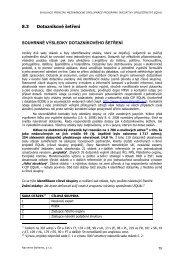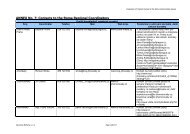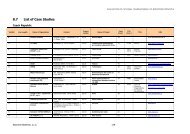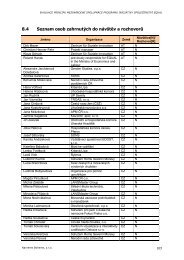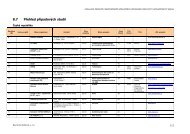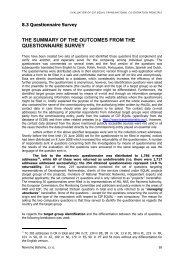EQUAL - Final report - eng - navreme
EQUAL - Final report - eng - navreme
EQUAL - Final report - eng - navreme
Create successful ePaper yourself
Turn your PDF publications into a flip-book with our unique Google optimized e-Paper software.
EVALUATION OF CIP <strong>EQUAL</strong> TRANSNATIONAL CO-OPERATION PRINCIPLE<br />
The question wording: How would you define your relationship to the Community Initiative<br />
Programme <strong>EQUAL</strong>?<br />
QUESTION SET 12 TARGET GROUP<br />
1 Independent expert<br />
2 Politician / Decision Maker<br />
2 Representative of the Managing Authority<br />
2 Representative of the National Supporting Structure<br />
2 ESF or HRD policy maker<br />
2 Representative of the European Commission<br />
1 Representative of the Development Partnership<br />
1 Ultimate beneficiary of services provided/initiated by CIP <strong>EQUAL</strong> projects<br />
2 Member of the Monitoring Committee<br />
1 Member of the National Thematic Network<br />
2 Member of the payment authority / payment unit<br />
1 Applicant or a person interested in getting involved in <strong>EQUAL</strong> project<br />
The received questionnaires were reviewed as follows:<br />
• The check for any double counting was done according to the date and time of the form<br />
sending, and subsequently according to answers (especially the open ones) – identified<br />
double counting (one in each set, two in total) were eliminated;<br />
• In the cases when less than 20 % of questions were filled in in the questionnaire (i.e.<br />
less than three out of eleven = the set of questions for the managing structures, or less than<br />
five out of nineteen = the set of questions for projects), the obtained answers were not used<br />
and the respective questionnaire was deleted from the database of results; this was applied 0<br />
times altogether in the case of managing structures and 6 times in the case of projects (out of<br />
which two were completely empty questionnaires, two with two answers and two with three<br />
answers);<br />
• There was carried out the check of answers to open questions of the “other:” type:<br />
o In the case an answer was filled in, but the “other” possibility was not ticked off and it<br />
was a multiple-possibilities-choice – the “other” possibility was ticked off;<br />
o In the case an answer was filled in, but the “other” possibility was not ticked off and it<br />
was a choice of one possibility only and none of the possibilities was ticked off - the<br />
“other” possibility was ticked off;<br />
o In the case an answer was filled in, but the “other” possibility was not ticked off and it<br />
was a choice of one possibility only and another of the possibilities had already been<br />
ticked off – the answer obtained under the “other” column was not used (it was<br />
deleted).<br />
After the above mentioned adaptations have been done, the number of analysed answers<br />
furthermore decreased by eight ones to the final 212 questionnaires aimed at specific<br />
projects or recipients, and 34 questionnaires filled in by members of managing structures,<br />
i.e. to 246 in total.<br />
All the above mentioned corrections were a necessary step towards the homogenization of obtained<br />
data, not having any negative influence neither on the answers nor on the results of the investigations<br />
by means of questionnaires.<br />
12<br />
The term projects covers set of questions no.1 and the term managing structures covers set of<br />
questions no.2.<br />
Navreme Boheme, s.r.o. 66



